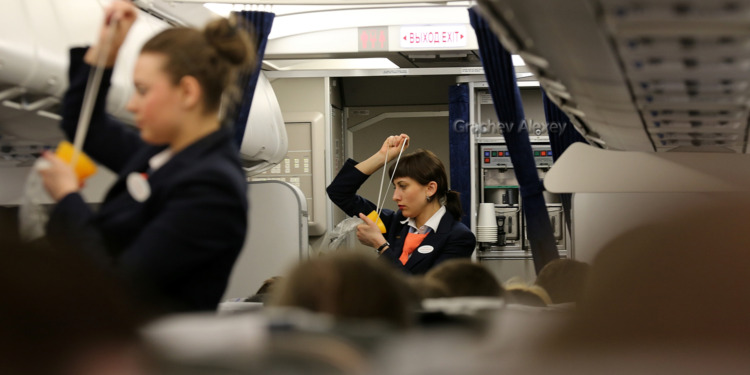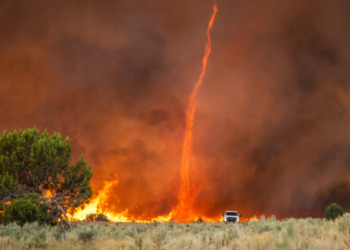As our planet warms due to the burning of fossil fuels, atmospheric dynamics undergo significant changes that impact winds at various altitudes. The implications of these alterations are far from trivial.
Multiple studies have shown a clear link between Earth’s warming and the elevated risks of encountering turbulent conditions during air travel.
Atmospheric dynamics have in fact experienced significant transformations since scientists began observing them via satellite data in the late 1970s. As researchers have demonstrated, wind shear, which refers to the variations in wind speeds at different altitudes, has escalated by 15 percent since 1979.
When atmospheric disturbances akin to rippling waves are created, flights become prone to bumpy rides that can startle even the most seasoned travelers. Especially since the frequency of such turbulence is on the rise, creating an urgent need to address the impact of climate change on air travel safety.
A particularly dangerous form of turbulence is known as clear-air turbulence (CAT).
This hazard presents a significant challenge for pilots and passengers alike. Unlike other types of turbulence, CAT develops in cloud-free environments in the upper-level atmosphere, providing no visual cues to pilots and escaping detection by onboard radar systems. It seems to emerge out of nowhere, catching both crew and passengers off guard.
Recent research from Reading University has brought to light an in-depth analysis of the escalating effects of climate change on turbulence. In one of the busiest flight routes in the world, the North Atlantic corridor, the annual duration of severe turbulence has surged by a staggering 55% since 1979, with 2020 clocking in at 27.4 hours compared to 17.7 hours in 1979. These findings paint a sobering picture of the challenges ahead and reinforce the pressing need to tackle climate change on a global scale.
The increased frequency of turbulence, particularly clear-air turbulence, poses a significant safety concern for the aviation industry. The increasing turbulence levels during flights not only disrupt the comfort and tranquility of passengers but also raise concerns about their safety.
While the occurrence of injuries during turbulence remains rare, incidents in recent years have highlighted the potential risks involved. According to data from the Federal Aviation Administration (FAA) in the US, from 2009 to 2021, turbulence resulted in 146 serious injuries, with 30 passengers and 116 crew members affected. These statistics emphasize the need to address the impact of turbulence on flight security.
Several noteworthy accidents serve as stark reminders of the potential dangers posed by severe turbulence.
In early March, a Lufthansa flight from Austin, Texas, to Frankfurt, Germany, encountered significant turbulence, injuring seven passengers. The plane was forced to divert to Dulles International Airport outside Washington, D.C.
A Lufthansa flight that experienced “significant turbulence” was diverted to Virginia and seven people were taken to hospitals.
Social media footage showed food trays, screens, pillows and other items scattered inside the plane: https://t.co/D2vkkFmhNJ pic.twitter.com/wUOgdiB4XH
— The Associated Press (@AP) March 2, 2023
Similarly, in December 2022, a Hawaiian Airlines flight from Phoenix to Honolulu experienced severe turbulence, resulting in injuries to three dozen individuals, eleven of whom were seriously hurt. These incidents necessitated medical attention upon landing.
The unpredictability of turbulence was exemplified by a short-lived but intense turbulence event on a United Airlines flight from San Francisco to Munich, Germany. The flight had to divert to Denver when a flight attendant suffered a serious injury.
While the number of injuries remains relatively low compared to the overall number of flights, these incidents demonstrate the potential risks associated with turbulence, which can occur suddenly and without warning, leading to injuries and disruptions in flight operations.
Looking ahead, the future of air travel in relation to turbulence and climate change presents both challenges and opportunities. Addressing the issue of turbulence requires a multifaceted approach that encompasses technological advancements, flight planning strategies, and environmental considerations.
Related Articles: Humans Worsen 71% of Extreme Weather Events | Climate Change Impacts Insects | Climate Change Is Making Heatwaves 10 Times More Likely | Icelandair Announces Carbon-Free Flights by 2030
As the aviation industry strives to decarbonize and reduce its environmental impact, finding sustainable solutions becomes crucial. Alternative fuels and electric batteries are being explored, but their widespread adoption is hindered by high costs and limited availability.
Balancing the need for reduced emissions with the growing demand for air travel poses a significant challenge. Alethea Warrington, a senior campaigner at climate charity Possible, suggests taxing frequent flying, curbing airport expansions, and banning private jets as measures to mitigate the environmental consequences of air travel.
Flight planning also plays a crucial role in mitigating turbulence encounters. Climate models are utilized to predict areas of rapid changes in wind speed and direction, allowing dispatchers to plan routes that avoid turbulence-prone regions.
However, a paradox arises as airlines aim for shorter, more efficient routes to reduce emissions, potentially increasing the likelihood of encountering turbulence. Striking a balance between emission reduction and turbulence avoidance remains a complex challenge.
Addressing climate change and its consequences is vital not only for the health of our planet but also for ensuring smoother and safer journeys through the skies.
Climate change and turbulence are becoming intertwined realities of air travel.
Balancing environmental concerns, technological advancements, and safety requirements will be crucial in shaping a future where air travel is both sustainable and secure.
Editor’s Note: The opinions expressed here by the authors are their own, not those of Impakter.com — In the Featured Photo:Safety equipment demonstration. Featured Photo Credit: Alexey Grachev.









